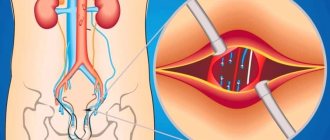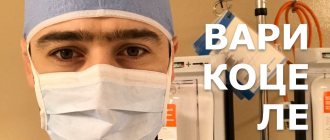Men, by their nature, do not notice the primary signs of varicose veins. This is the biggest mistake! Varicose veins are as common in men as in women. According to WHO statistics, every fourth man is diagnosed with varicose veins of varying severity. The pathology is getting younger, and if previously problems with veins appeared after 40 years, today the patient’s age can be half that. If the disease is not treated, it can lead to trophic ulcers and even amputation of the affected area. But you can avoid unpleasant consequences - the main thing is to consult a doctor in time.
Statistics
Due to the anatomical features of the veins in the testicular area, varicocele most often forms on the left side. 80-95% are allocated to these cases. Right-sided testicular varicose veins are not so common (up to 8%). On both sides, varicocele occurs in 2-12 cases out of a hundred. Male disease is “linked” to the age of the patients. A large percentage (19) of problems with testicular veins are noted by doctors in adolescents. If we consider the reproductive age of men, then the statistics of varicose veins reach 35%. These are sad numbers, because... Varicocele in sexually mature men can cause infertility. Treatment of the disease should begin at the earliest stages.
Veins should not be visible
Lately the veins on my hands have appeared. On both. And also on the forearms. This didn't happen before. I have been involved in weightlifting for many years and now I “dabble” in lifting iron. Is this the only reason? And what needs to be done to ensure that they are not visible? Among other things, they also began to ache. Andrey Burov, Stavropol
Protruding veins on the arms are most often just an aesthetic problem. As the author of the question states, they are indeed noticeable on the hands (especially on the middle and index fingers), wrists and forearms, and sometimes on the shoulders. According to statistics provided by doctors, this phenomenon is observed more often in men than in women.
HOWEVER, it is very important to understand and be able to distinguish in which case this symptom is one of the variants of the norm, a normal physiological condition, and in which case it is a pathology and requires diagnosis and treatment .
The fact is that a person has veins throughout his body. Only mostly they are securely hidden under the skin. But there are situations when they appear, and sometimes they also hurt.
So, in people who, like the author of the question, are actively involved in sports, veins appear much more often than in others. Especially among bodybuilders, bodybuilders, weightlifters. In this case, increased venousness and pulsation are due to the fact that during training the athlete’s arms have a huge load - the vessels from the inside bulge the muscles.
Support the publication
- Join the CLAN
Or
But besides athletes, veins can also bulge in people who do a lot of physical activity, especially if it is on their arms. These are, for example, loaders, construction workers, slingers and others. Also, similar physiological characteristics appear in older people as a result of aging of the body . Since the elasticity of blood vessels begins to lose with age, the walls of the veins are unable to maintain their shape.
Increased venousness can also be hereditary, manifesting itself during pregnancy and in the period after childbirth. In this condition, bulging veins in women is also a physiological process associated with hormonal changes in the body . and overheating of the patient in a bathhouse or sauna also affect this process Smoking, a fragile physique, thin translucent skin (especially in girls, teenage boys and children) with a small layer of subcutaneous fat that could hide blood vessels may well cause provocation.
Most often, these manifestations are temporary and do not require serious treatment. If the veins either swell or disappear, this may indicate a temporary circulatory disorder . In this situation, there is no point in trying to reduce them; they must hide on their own.
However, you should approach the problem very seriously if it arose as a result of diseases and begins to be pathological in nature. The most common disease is varicose veins . The origin of this disease is associated with a decrease in the tone of the venous walls. Pain often occurs. However, it is known that the same symptoms also appear in arthritis, arthrosis, and chondrosis. And here correct diagnosis is very important, which will determine the disease and, accordingly, the correct treatment methods. The neglected process can lead to the formation of blood clots, better known as thrombi, and the disease itself is called thrombosis . And this is a condition that threatens human life. The situation is complicated by the fact that such a pathology is quite difficult to detect in the early stages, while the superficial vessels have not yet emerged, and it is practically not accompanied by symptoms.
In addition to varicose veins and thrombosis, pathologies also include thrombophlebitis (when the veins turn dark blue, and in advanced cases they turn black and hurt very much) and postphlebitic syndrome . Most of these pathological manifestations are characterized by fever, muscle weakness, swelling and other symptoms.
Therefore, we repeat once again: correct and modern diagnosis is very important. Usually, MRI of the veins and ultrasound of the vessels of the upper extremities are performed. The most modern diagnostic method for the occurrence of symptoms of varicose veins and phlebitis (inflammation of the walls of the veins) is considered to be duplex sonography (ultrasound examination of blood vessels).
Laser therapy is used to treat identified diseases. Physiotherapeutic procedures are very useful: electrophoresis, magnetic therapy, ultrasound treatment, balneotherapy (whirlpool and contrast hand baths with bischofite, radon, hydrogen sulfide), massage compression.
Another popular method is hirudotherapy (treatment with leeches). It is practiced when the hands become swollen due to insufficient blood flow. Despite the folk, unconventional nature of the treatment method, doctors consider it effective and often use it. And patient reviews are also positive. They note an improvement in the appearance of their hands and overall well-being after the first session.
In the most extreme case, if all these measures, including drug treatment, have not given the desired effect, surgery is prescribed.
In order not to resort to treatment and the most extreme measures, as in other cases, prevention is important. It is universal in many ways. Quitting bad habits (alcohol, smoking, sedentary lifestyle). You should also give up coffee and eat right.
Therefore, if any problems with the veins appear, you need to consult a doctor as soon as possible. Usually a phlebologist deals with this problem, but at the very beginning you can also contact a therapist, who, if necessary, will refer you to the right specialist.
Add AN to your sources so as not to miss important events - Yandex News
Become a member of the CLAN and every Tuesday you will receive the latest issue of “Arguments of the Week” with a discount of more than 70%, along with exclusive materials not included in the newspaper. Get premium access to a library of the most interesting and popular books, as well as an archive of more than 700 published issues for FREE. In addition, you will have the opportunity to benefit from free legal advice from our experts for a whole year.
- Enter your email address, then select any convenient payment method for your annual subscription
- Scan the QR. In the Sberbank Online application that opens, enter the annual subscription cost (490 rubles). Then send the confirmation code by email
Or
Stay with us. Add us to your sources and subscribe to our social networks.
Yandex Zen Telegram Google News MirTesen Twitter VKontakte Odnoklassniki Facebook
What does it look like
A photo of a varicocele clearly demonstrates a male problem - the scrotum on one side (usually the left) is slightly lower. The skin covering the testicle does not hide the contours of the veins. When self-palpating the venous vessels, a man can feel their expansion. The patient may not even be aware of other symptoms of the disease. Palpation of the scrotum and visual examination are necessary actions for all men who care about their health. This is especially true for males planning fatherhood. You need to be regularly examined by a urologist. Medical examinations and consultations with qualified specialists are offered by the Global Clinic Center, which has extensive experience in the treatment of varicocele.
History of the disease
Varicocele is a disease with deep historical roots. The first mention of the problem dates back to the 16th century and is associated with the name of Paré, a famous surgeon of the Renaissance. He drew attention to the pathology of the venous vessels near the male testicle. Many medical historians speak of the involvement of Hippocrates and Celsius in establishing the facts about this problem. The topic of varicocele is very closely related to infertility. In the 19th and 20th centuries, scientists confirmed the possibility of curing male infertility in direct proportion to the elimination of testicular varicose veins.
Varicocele. Symptoms
The danger of the first stages of the disease is that it is asymptomatic. The problem is discovered by chance, during medical examinations or when patients address other male issues (for example, in connection with infertility). Symptoms of varicocele characteristic of other degrees of the disease:
- nagging pain and discomfort in the left side of the scrotum, testicle and groin area;
- drooping left (mostly) testicle, interfering with walking;
- decrease in the size of the testicle on the left;
- manifestation of the contours of venous vessels;
- appearance of pain.
Varicocele is characterized by symptoms manifested in a decrease in the number of sperm and a decrease in their motility, in this case it is worth talking about male infertility. When doctors try to find out the cause of male infertility and analyze various symptoms in a patient, they often discover a varicocele, using the most modern diagnostic methods.
How does varicocele affect infertility?
Enlarged veins interfere with proper blood flow in the groin area, which disrupts thermoregulation in the testicles. For sperm to mature, a temperature below body temperature is required. Stagnation of venous blood leads to overheating, and germ cells develop poorly.
Another factor in the influence of varicocele on conception is the entry of immune system cells into the testicle. They mark the sperm as foreign and begin to attack them. This leads not only to the destruction of germ cells, but also to the development of an autoimmune disease with inflammation and deterioration of well-being.
Causes and risk factors for the disease
In the veins surrounding the spermatic cord, a malfunction of the valve occurs, which prevents blood from flowing back. Instead of rising upward, the blood stagnates, because... is transmitted in the opposite direction. Because of this, the venous vessels become dilated and weak. The causes and risk factors of varicocele are associated with the appearance of primary and secondary reflux. The abnormal structure of the veins associated with congenital pathology leads to the complete absence of valves for the reverse outflow of blood or their atypical operation. During puberty, blood pressure on the vessels increases, and varicose changes occur in the veins near the spermatic cord. The weak walls of blood vessels inherited from birth by boys cannot cope with the flow of blood during physiological changes. As a rule, varicocele is inherited, so this should be taken into account in case of male infertility and comprehensive treatment of testicular varicose veins should be carried out. Secondary reflux occurs when the blood outflow valves stop functioning normally due to problems in the renal or vena cava. Varicose veins most often occur on the left side, because it is on the left that the venous vessels meet the renal vein. Narrowing of the lumen in the latter structure can cause varicocele. Unfavorable factors for testicular varicose veins:
- haemorrhoids;
- phlebeurysm.
The following are considered as a trigger for the appearance of varicocele:
- Hard physical labor.
- Extreme loads in sports or weight lifting.
- Lack of normal sex life.
- Professions that require long periods of standing.
- Chronic constipation.
Causes of the disease
Varicocele is one of the most common diseases among men, affecting 15 to 20% of the population. The risk group includes young people from 14 to 25 years old who lead an active lifestyle (sports, heavy physical work).
In addition, an increase in venous pressure may be a factor that contributes to the development of the disease.
ICD-10 divides varicocele into three stages. During the first, varicose veins cannot be determined by palpation, and for diagnosis it is necessary to do a special test - the Valsalva maneuver. At the second stage, dilated veins can be felt, but they cannot be visually noticed. And finally, at the last stage, varicose veins are clearly visible to the naked eye, and testicular atrophy occurs.
At first, varicocele is asymptomatic, but after some time it enters the open phase and is accompanied by periodic nagging pain in the scrotum area.
Complications
The main thing that patients suffering from testicular varicose veins need to understand is the serious situation with the appearance of offspring. Infertility can become a sad complication of varicocele, so you should not delay going to the clinic for diagnosis and treatment. Doctors from the Global Clinic Center can provide qualified assistance. Statistics show that patients diagnosed with varicocele in 60 cases out of a hundred are faced with the problem of sperm dysfunction. 40% of men with testicular varicose veins become infertile.
Diagnostics
To effectively treat the disease, you need to use all diagnostic methods. To detect varicocele, experienced specialists only need to visually examine the patient and palpate the plexus of testicular venous vessels in the form of a cluster. The man is examined in a standing position, in a calm state. To clarify the results of palpation, the patient is asked to tense the abdominal muscles (Valsalva maneuver) to improve the filling of testicular vessels with blood. In this case, the study of the enlarged area will be more complete. This will help in diagnosing grade 2-3 varicocele; if the problem is not expressed, you will need the help of modern equipment. Ultrasound and doplegraphic examination of the scrotum is necessary to clarify the diagnosis. The patient must be examined in two positions - standing and sitting. To rule out infertility, a man needs to have a spermogram. One semen examination is not enough; examination in the interval from 4 to 12 weeks will make the diagnosis more accurate. This diagnosis is very informative; it can be used to determine the type of varicocele, obtain data on the size of the testicle, the location of diseased veins, and thickening of the spermatic cord.
Classification
The degrees of the disease are classified based on the dilation of the veins of the spermatic cord and testicle. The development of varicocele is divided into 4 degrees. They speak of zero degree if the symptoms of the disease cannot be determined visually or by manual palpation. Only instrumental examination (most often when diagnosing other problems) reveals varicocele. Grade 1 is diagnosed when the dilation of the veins cannot be palpated with the patient lying down, only standing. In patients with the 2nd degree of the disease, the doctor feels with his hands an increase in the venous vessels of the spermatic cord and testicle in men who are sitting and standing. To determine the third degree of varicocele, a visual examination of the patient is sufficient. If we consider testicular varicose veins from the point of view of the location of the pathology, then we distinguish left-, right- and bilateral varicoceles. Subclinical and clinical types of the disease are classified depending on physical examination methods.
Gradual development of varicocele
Damage to the veins occurs gradually, the clinical picture is constantly changing.
- Initially, there are no external signs of varicocele in men; it can be determined at the first stage only through palpation when the patient’s body is placed vertically.
- At the second stage, the size and consistency of the testicles remain the same, but the enlarged veins are clearly visible.
- At the third stage, the cluster-shaped dilatation of the veins is pronounced, the testicles become denser to the touch and decrease in size.
Treatment
The problem of varicose veins in the vessels of the spermatic cord and testicle cannot be eliminated. Improper operation of the blood outflow valves can be corrected through surgery. Surgical treatment of varicocele is the main method. The effectiveness of medication use is insignificant. Only the first stages of the disease can be treated conservatively. Consultation with a doctor and a joint decision on surgery for varicocele are mandatory. Surgical intervention is not always necessary for the patient. If the disease does not bother the man too much, or the patient is of advanced age, then doctors advise not to undergo surgery. A variety of surgical methods helps doctors find the only correct method. The essence of the operation for varicocele is to ligate the venous pathological vessels and normalize the outflow of blood. To save the results obtained during the operation, you should:
- limit physical and sexual stress;
- come to your doctor for examination.
How is varicocele treated?
In the initial stages of the disease, when the patient is not yet bothered by severe pain, male varicose veins (varicocele) are treated with medications and a special support bandage. In later stages, taking medications can only increase the effectiveness of treatment, but they will no longer be able to cope with the pathology on their own. If there are complaints of severe pain, therapeutic exercises, massage, and compliance with certain conditions are prescribed that will prevent the progression of varicocele.
A man should give up excessive physical activity, normalize intestinal function, eliminate foods high in cholesterol from the diet, give up bad habits, and wear tight, but not tight, underwear.
For varicocele, treatment can also be surgical. This method is used in advanced stages of the disease. The phlebologist may prescribe the patient laparoscopy or Marmara surgery.
During laparoscopy, a man is given a small puncture and a clamp is applied to block the flow of blood into a vein that has become deformed. A small hole is also made near the umbilical cavity, where a microcamera is inserted, with the help of which the progress of the operation is monitored.
Marmara surgery is performed under a microscope. An incision is made to the patient and, using a microscope, the veins of the testicle, which are deformed due to varicose veins, are ligated.







